Most herbs produce lovely little flowers, which are often sweetly scented and magnets for pollinators. They also have attractive leaves and grow in appealing ways. Using edibles as ornamentals is the perfect solution for smaller yards, where there is often no room for a dedicated vegetable patch. Many hardy evergreen herbs will persist in winter, adding much-needed greenery to the garden. While you can enjoy herbs purely as ornamental plants, their aroma and usefulness in the kitchen are integral to their appeal. Situating these beautiful herbs close to the kitchen will make it easy for you to harvest them regularly for cooking.
1. Basil
The most commonly grown basil, Sweet Genovese, is pretty enough, with gentle white spires of flowers on the softly rounded leaves. However, a host of other types of basil offer even more diversity in leaf, stem, and flower, as well as flavor. There are several types of purple basil, offering bright eggplant-hued leaves and stems. Cinnamon basil has small, green leaves with purple veins and bright purple flowers. Cardinal basil produces richly red blooms. Green Ruffles basil was developed with fluted leaves, while African Blue basil bears long spires of blue blooms. Basil is an annual in most regions but growing basil indoors is an option when cool temperatures threaten. Plants require a full sun location and average water. Most basil is hardy to USDA zones 9-11.
2. Chamomile
Known for the flavorful tea made from the flowers, chamomile is also a very ornamental plant. Spice up dishes and dazzle your taste buds with this aromatic basil trio, which includes the sweet and spicy Genovese, the purple-hued Corsican, and the zesty lemon basil. With feathery leaves and cheery white rayed blooms with yellow centers, this herb is easy to grow. It prefers sandy, well-drained soil and average water. Full sun to partial shade are both suitable. Chamomile’s happy little flowers are perfect in the herb garden, an annual bed, mixed in with flowering perennials, or even in containers. The flowers can be used either fresh or dried and steeped into a delicious, calming tea. Chamomile is suitable for USDA zones 4-9.
4. Sage
There are over 1,000 species in the sage family. The pungent stems, leaves, and flowers have a strong flavor often used with poultry. German chamomile is a delightful annual herb that stands out in your garden but also boasts a history of medicinal use that stretches back thousands of years. Depending on the species, the flowers range from purple, blue-purple, white, red, and pink. The soft leaves may be green, variegated, or gray. White, Scarlett, Baby, and Common sages are but a few. Sage needs well-draining soil of average fertility. It performs best in full sun but can tolerate a bit of shade. It is hardy to USDA zones 5-8.
3. Allium
Chives, garlic, leeks, and onions are all in the allium family. While there are bulbs that are sold strictly for the flowers and not for eating, culinary alliums also produce lovely blooms. This set of two compact oval-shaped metal beds, measuring H17xW24 inches, is perfect for growing herbs, or small fruit trees. Regular price $189.95. A tight cluster of tiny starry flowers caps the plants during the season. Garlic chives have white flower clusters, while regular chives have deeply purple blooms. Alliums are easy to grow provided the soil is well draining. They need average fertility and water. Rotate allium crops as there are several in-ground pests that will destroy the bulbs. Plants are hardy in USDA zones 3-9.
5. Artemisia
Artemisia, or wormwood, grows wild in many locations of the world and has a long history of use in traditional medicines. It is a sharply scented plant, reminiscent of an evergreen aroma. Not only are chives culinary stars, but their lavender-pink blooms pair beautifully with roses, and their strong scent acts as a natural pest deterrent in the garden. The flowers are insignificant but there is a diverse variety of leaf form and color. Ranging from dark green to dusty gray, leaves may be lobed or needle-like. Artemisia prefers full sun to partial shade, consistently damp soil, and moderate fertility. Most varieties are hardy to USDA zones 3-8.
6. Catmint
Even if you aren’t a feline lover, you will appreciate the prolific blooms of catmint. This herb has grayish green, small leaves and an arching habit. The long blooming stems are adorned with deeply purple flowers that will be produced all season if they are cut back after flowering. Ensure great seed starts and propagations with this innovative bundle. Start with a 10x20 inch bottom tray, and then select the seedling tray size you prefer. Regular price $79.95. Catmint is irresistible to cats but also a useful addition to borders, rockeries, and perennial gardens. Catmint needs little care outside of occasional watering and deadheading. It will produce a dense, small shrub over time. Hardy to USDA 3-8.
7. Borage
Borage is certainly one of the more unusual-looking herbs. It forms a small bush and has green, pointed leaves, lightly furred stems, and fuzzy flowers. Featuring a sleek slatted design inspired by classic wooden planters and the latest TruDrop self-watering technology, this planter box is ideal for an herb garden. The blooms are blue, with five petals and soft, downy fur. There are also white and pink flowering varieties. The plant is served like a vegetable, steamed or sauteed. It requires loose soil of average fertility and some shelter from the noonday sun. Borage may be grown in USDA zones 3-10.
8. Bee Balm
There are many cultivars of bee balm with flowers ranging from scarlet to white, to lavender. Perfect for herbs, these Rim planters mimic traditional Italian rimmed containers but have self-watering functionality and a double-wall design to insulate plants’ roots. The sap of the plant is known to soothe stings, but it is also a culinary herb with a slightly minty flavor. Bees and other pollinators like hummingbirds are very attracted to the flowers. Composed of many tubular petals that resemble arachnid legs, the blooms are spidery, but the effect is extremely alluring. Bee balm is a perennial in USDA zones 4-9.
Other Ornamental Herbs
As well as those highlighted above, there are other pretty herb varieties to add to the ornamental garden: Designed for utility and comfort, the Vego Garden Tool Bag is perfect for storing tools, water, and anything else you need for a day out in the garden.
The many varieties of thyme make wonderful ground cover with brilliantly colored flowers in spring and have a variety of leaf forms.Marjoram grows straight and tall with lovely soft lavender blooms.Both curly and flat-leaf parsley have attractive foliage.Rosemary, with its soft needle-like foliage and purple blooms, makes a large impactful bush with an irresistible scent.Often considered an ornamental plant, lavender has woody stems, attractive foliage, and strongly scented blooms with multiple uses.
This article features products available from third-party vendors on the Gardening Know How Shop.
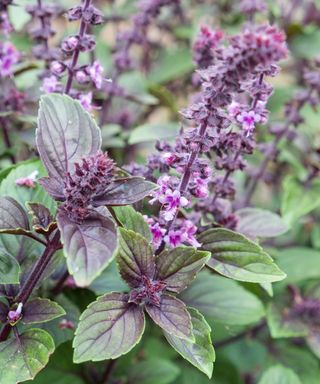
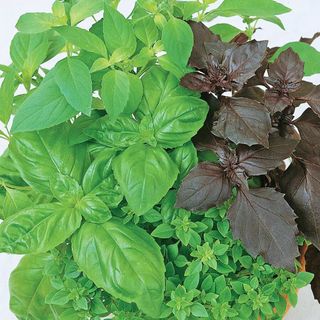
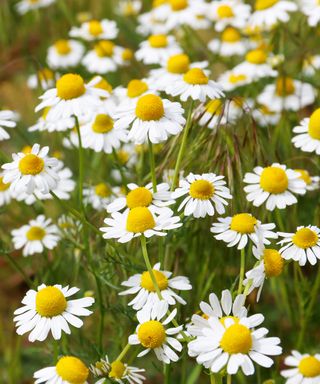
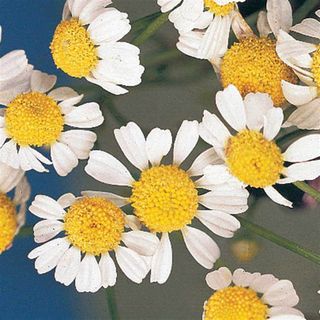
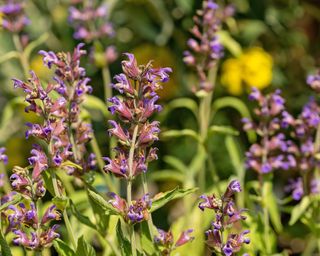
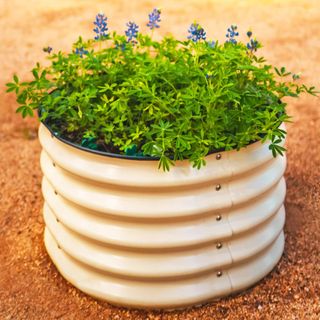
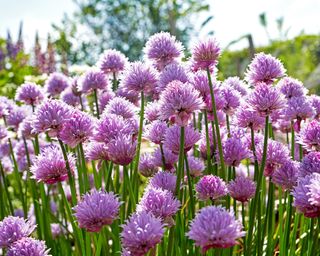
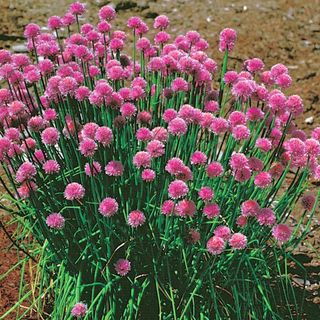
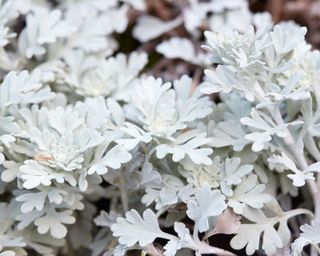
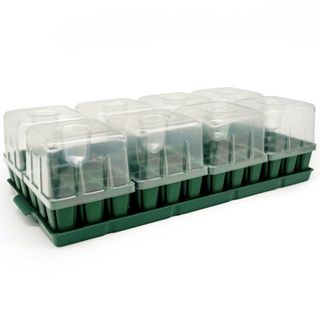
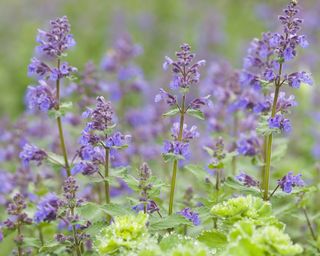
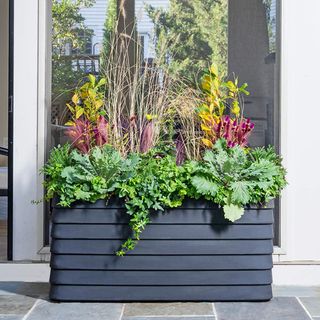
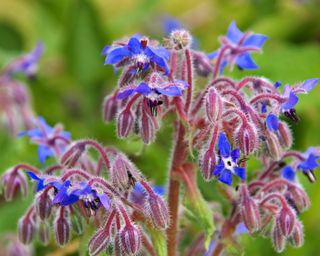
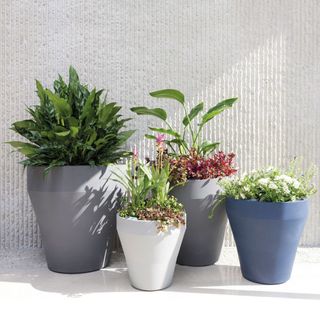
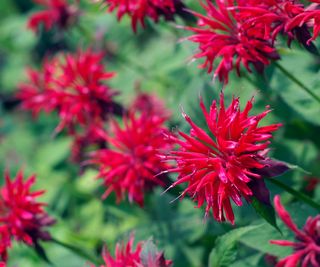
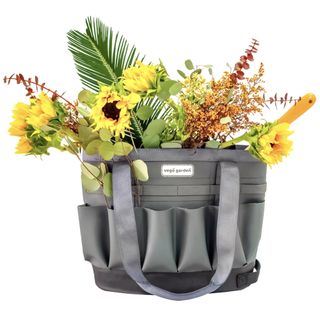
title: “8 Beautiful Herbs That Belong In Flowerbeds” ShowToc: true date: “2024-09-06” author: “Anastasia Griswold”
Most herbs produce lovely little flowers, which are often sweetly scented and magnets for pollinators. They also have attractive leaves and grow in appealing ways. Using edibles as ornamentals is the perfect solution for smaller yards, where there is often no room for a dedicated vegetable patch. Many hardy evergreen herbs will persist in winter, adding much-needed greenery to the garden. While you can enjoy herbs purely as ornamental plants, their aroma and usefulness in the kitchen are integral to their appeal. Situating these beautiful herbs close to the kitchen will make it easy for you to harvest them regularly for cooking.
1. Basil
The most commonly grown basil, Sweet Genovese, is pretty enough, with gentle white spires of flowers on the softly rounded leaves. However, a host of other types of basil offer even more diversity in leaf, stem, and flower, as well as flavor. There are several types of purple basil, offering bright eggplant-hued leaves and stems. Cinnamon basil has small, green leaves with purple veins and bright purple flowers. Cardinal basil produces richly red blooms. Green Ruffles basil was developed with fluted leaves, while African Blue basil bears long spires of blue blooms. Basil is an annual in most regions but growing basil indoors is an option when cool temperatures threaten. Plants require a full sun location and average water. Most basil is hardy to USDA zones 9-11.
2. Chamomile
Known for the flavorful tea made from the flowers, chamomile is also a very ornamental plant. Spice up dishes and dazzle your taste buds with this aromatic basil trio, which includes the sweet and spicy Genovese, the purple-hued Corsican, and the zesty lemon basil. With feathery leaves and cheery white rayed blooms with yellow centers, this herb is easy to grow. It prefers sandy, well-drained soil and average water. Full sun to partial shade are both suitable. Chamomile’s happy little flowers are perfect in the herb garden, an annual bed, mixed in with flowering perennials, or even in containers. The flowers can be used either fresh or dried and steeped into a delicious, calming tea. Chamomile is suitable for USDA zones 4-9.
4. Sage
There are over 1,000 species in the sage family. The pungent stems, leaves, and flowers have a strong flavor often used with poultry. German chamomile is a delightful annual herb that stands out in your garden but also boasts a history of medicinal use that stretches back thousands of years. Depending on the species, the flowers range from purple, blue-purple, white, red, and pink. The soft leaves may be green, variegated, or gray. White, Scarlett, Baby, and Common sages are but a few. Sage needs well-draining soil of average fertility. It performs best in full sun but can tolerate a bit of shade. It is hardy to USDA zones 5-8.
3. Allium
Chives, garlic, leeks, and onions are all in the allium family. While there are bulbs that are sold strictly for the flowers and not for eating, culinary alliums also produce lovely blooms. This set of two compact oval-shaped metal beds, measuring H17xW24 inches, is perfect for growing herbs, or small fruit trees. Regular price $189.95. A tight cluster of tiny starry flowers caps the plants during the season. Garlic chives have white flower clusters, while regular chives have deeply purple blooms. Alliums are easy to grow provided the soil is well draining. They need average fertility and water. Rotate allium crops as there are several in-ground pests that will destroy the bulbs. Plants are hardy in USDA zones 3-9.
5. Artemisia
Artemisia, or wormwood, grows wild in many locations of the world and has a long history of use in traditional medicines. It is a sharply scented plant, reminiscent of an evergreen aroma. Not only are chives culinary stars, but their lavender-pink blooms pair beautifully with roses, and their strong scent acts as a natural pest deterrent in the garden. The flowers are insignificant but there is a diverse variety of leaf form and color. Ranging from dark green to dusty gray, leaves may be lobed or needle-like. Artemisia prefers full sun to partial shade, consistently damp soil, and moderate fertility. Most varieties are hardy to USDA zones 3-8.
6. Catmint
Even if you aren’t a feline lover, you will appreciate the prolific blooms of catmint. This herb has grayish green, small leaves and an arching habit. The long blooming stems are adorned with deeply purple flowers that will be produced all season if they are cut back after flowering. Ensure great seed starts and propagations with this innovative bundle. Start with a 10x20 inch bottom tray, and then select the seedling tray size you prefer. Regular price $79.95. Catmint is irresistible to cats but also a useful addition to borders, rockeries, and perennial gardens. Catmint needs little care outside of occasional watering and deadheading. It will produce a dense, small shrub over time. Hardy to USDA 3-8.
7. Borage
Borage is certainly one of the more unusual-looking herbs. It forms a small bush and has green, pointed leaves, lightly furred stems, and fuzzy flowers. Featuring a sleek slatted design inspired by classic wooden planters and the latest TruDrop self-watering technology, this planter box is ideal for an herb garden. The blooms are blue, with five petals and soft, downy fur. There are also white and pink flowering varieties. The plant is served like a vegetable, steamed or sauteed. It requires loose soil of average fertility and some shelter from the noonday sun. Borage may be grown in USDA zones 3-10.
8. Bee Balm
There are many cultivars of bee balm with flowers ranging from scarlet to white, to lavender. Perfect for herbs, these Rim planters mimic traditional Italian rimmed containers but have self-watering functionality and a double-wall design to insulate plants’ roots. The sap of the plant is known to soothe stings, but it is also a culinary herb with a slightly minty flavor. Bees and other pollinators like hummingbirds are very attracted to the flowers. Composed of many tubular petals that resemble arachnid legs, the blooms are spidery, but the effect is extremely alluring. Bee balm is a perennial in USDA zones 4-9.
Other Ornamental Herbs
As well as those highlighted above, there are other pretty herb varieties to add to the ornamental garden: Designed for utility and comfort, the Vego Garden Tool Bag is perfect for storing tools, water, and anything else you need for a day out in the garden.
The many varieties of thyme make wonderful ground cover with brilliantly colored flowers in spring and have a variety of leaf forms.Marjoram grows straight and tall with lovely soft lavender blooms.Both curly and flat-leaf parsley have attractive foliage.Rosemary, with its soft needle-like foliage and purple blooms, makes a large impactful bush with an irresistible scent.Often considered an ornamental plant, lavender has woody stems, attractive foliage, and strongly scented blooms with multiple uses.
This article features products available from third-party vendors on the Gardening Know How Shop.
















title: “8 Beautiful Herbs That Belong In Flowerbeds” ShowToc: true date: “2024-08-27” author: “Theodore Emme”
Most herbs produce lovely little flowers, which are often sweetly scented and magnets for pollinators. They also have attractive leaves and grow in appealing ways. Using edibles as ornamentals is the perfect solution for smaller yards, where there is often no room for a dedicated vegetable patch. Many hardy evergreen herbs will persist in winter, adding much-needed greenery to the garden. While you can enjoy herbs purely as ornamental plants, their aroma and usefulness in the kitchen are integral to their appeal. Situating these beautiful herbs close to the kitchen will make it easy for you to harvest them regularly for cooking.
1. Basil
The most commonly grown basil, Sweet Genovese, is pretty enough, with gentle white spires of flowers on the softly rounded leaves. However, a host of other types of basil offer even more diversity in leaf, stem, and flower, as well as flavor. There are several types of purple basil, offering bright eggplant-hued leaves and stems. Cinnamon basil has small, green leaves with purple veins and bright purple flowers. Cardinal basil produces richly red blooms. Green Ruffles basil was developed with fluted leaves, while African Blue basil bears long spires of blue blooms. Basil is an annual in most regions but growing basil indoors is an option when cool temperatures threaten. Plants require a full sun location and average water. Most basil is hardy to USDA zones 9-11.
2. Chamomile
Known for the flavorful tea made from the flowers, chamomile is also a very ornamental plant. Spice up dishes and dazzle your taste buds with this aromatic basil trio, which includes the sweet and spicy Genovese, the purple-hued Corsican, and the zesty lemon basil. With feathery leaves and cheery white rayed blooms with yellow centers, this herb is easy to grow. It prefers sandy, well-drained soil and average water. Full sun to partial shade are both suitable. Chamomile’s happy little flowers are perfect in the herb garden, an annual bed, mixed in with flowering perennials, or even in containers. The flowers can be used either fresh or dried and steeped into a delicious, calming tea. Chamomile is suitable for USDA zones 4-9.
4. Sage
There are over 1,000 species in the sage family. The pungent stems, leaves, and flowers have a strong flavor often used with poultry. German chamomile is a delightful annual herb that stands out in your garden but also boasts a history of medicinal use that stretches back thousands of years. Depending on the species, the flowers range from purple, blue-purple, white, red, and pink. The soft leaves may be green, variegated, or gray. White, Scarlett, Baby, and Common sages are but a few. Sage needs well-draining soil of average fertility. It performs best in full sun but can tolerate a bit of shade. It is hardy to USDA zones 5-8.
3. Allium
Chives, garlic, leeks, and onions are all in the allium family. While there are bulbs that are sold strictly for the flowers and not for eating, culinary alliums also produce lovely blooms. This set of two compact oval-shaped metal beds, measuring H17xW24 inches, is perfect for growing herbs, or small fruit trees. Regular price $189.95. A tight cluster of tiny starry flowers caps the plants during the season. Garlic chives have white flower clusters, while regular chives have deeply purple blooms. Alliums are easy to grow provided the soil is well draining. They need average fertility and water. Rotate allium crops as there are several in-ground pests that will destroy the bulbs. Plants are hardy in USDA zones 3-9.
5. Artemisia
Artemisia, or wormwood, grows wild in many locations of the world and has a long history of use in traditional medicines. It is a sharply scented plant, reminiscent of an evergreen aroma. Not only are chives culinary stars, but their lavender-pink blooms pair beautifully with roses, and their strong scent acts as a natural pest deterrent in the garden. The flowers are insignificant but there is a diverse variety of leaf form and color. Ranging from dark green to dusty gray, leaves may be lobed or needle-like. Artemisia prefers full sun to partial shade, consistently damp soil, and moderate fertility. Most varieties are hardy to USDA zones 3-8.
6. Catmint
Even if you aren’t a feline lover, you will appreciate the prolific blooms of catmint. This herb has grayish green, small leaves and an arching habit. The long blooming stems are adorned with deeply purple flowers that will be produced all season if they are cut back after flowering. Ensure great seed starts and propagations with this innovative bundle. Start with a 10x20 inch bottom tray, and then select the seedling tray size you prefer. Regular price $79.95. Catmint is irresistible to cats but also a useful addition to borders, rockeries, and perennial gardens. Catmint needs little care outside of occasional watering and deadheading. It will produce a dense, small shrub over time. Hardy to USDA 3-8.
7. Borage
Borage is certainly one of the more unusual-looking herbs. It forms a small bush and has green, pointed leaves, lightly furred stems, and fuzzy flowers. Featuring a sleek slatted design inspired by classic wooden planters and the latest TruDrop self-watering technology, this planter box is ideal for an herb garden. The blooms are blue, with five petals and soft, downy fur. There are also white and pink flowering varieties. The plant is served like a vegetable, steamed or sauteed. It requires loose soil of average fertility and some shelter from the noonday sun. Borage may be grown in USDA zones 3-10.
8. Bee Balm
There are many cultivars of bee balm with flowers ranging from scarlet to white, to lavender. Perfect for herbs, these Rim planters mimic traditional Italian rimmed containers but have self-watering functionality and a double-wall design to insulate plants’ roots. The sap of the plant is known to soothe stings, but it is also a culinary herb with a slightly minty flavor. Bees and other pollinators like hummingbirds are very attracted to the flowers. Composed of many tubular petals that resemble arachnid legs, the blooms are spidery, but the effect is extremely alluring. Bee balm is a perennial in USDA zones 4-9.
Other Ornamental Herbs
As well as those highlighted above, there are other pretty herb varieties to add to the ornamental garden: Designed for utility and comfort, the Vego Garden Tool Bag is perfect for storing tools, water, and anything else you need for a day out in the garden.
The many varieties of thyme make wonderful ground cover with brilliantly colored flowers in spring and have a variety of leaf forms.Marjoram grows straight and tall with lovely soft lavender blooms.Both curly and flat-leaf parsley have attractive foliage.Rosemary, with its soft needle-like foliage and purple blooms, makes a large impactful bush with an irresistible scent.Often considered an ornamental plant, lavender has woody stems, attractive foliage, and strongly scented blooms with multiple uses.
This article features products available from third-party vendors on the Gardening Know How Shop.
















title: “8 Beautiful Herbs That Belong In Flowerbeds” ShowToc: true date: “2024-10-14” author: “Jennifer Brunelle”
Most herbs produce lovely little flowers, which are often sweetly scented and magnets for pollinators. They also have attractive leaves and grow in appealing ways. Using edibles as ornamentals is the perfect solution for smaller yards, where there is often no room for a dedicated vegetable patch. Many hardy evergreen herbs will persist in winter, adding much-needed greenery to the garden. While you can enjoy herbs purely as ornamental plants, their aroma and usefulness in the kitchen are integral to their appeal. Situating these beautiful herbs close to the kitchen will make it easy for you to harvest them regularly for cooking.
1. Basil
The most commonly grown basil, Sweet Genovese, is pretty enough, with gentle white spires of flowers on the softly rounded leaves. However, a host of other types of basil offer even more diversity in leaf, stem, and flower, as well as flavor. There are several types of purple basil, offering bright eggplant-hued leaves and stems. Cinnamon basil has small, green leaves with purple veins and bright purple flowers. Cardinal basil produces richly red blooms. Green Ruffles basil was developed with fluted leaves, while African Blue basil bears long spires of blue blooms. Basil is an annual in most regions but growing basil indoors is an option when cool temperatures threaten. Plants require a full sun location and average water. Most basil is hardy to USDA zones 9-11.
2. Chamomile
Known for the flavorful tea made from the flowers, chamomile is also a very ornamental plant. Spice up dishes and dazzle your taste buds with this aromatic basil trio, which includes the sweet and spicy Genovese, the purple-hued Corsican, and the zesty lemon basil. With feathery leaves and cheery white rayed blooms with yellow centers, this herb is easy to grow. It prefers sandy, well-drained soil and average water. Full sun to partial shade are both suitable. Chamomile’s happy little flowers are perfect in the herb garden, an annual bed, mixed in with flowering perennials, or even in containers. The flowers can be used either fresh or dried and steeped into a delicious, calming tea. Chamomile is suitable for USDA zones 4-9.
4. Sage
There are over 1,000 species in the sage family. The pungent stems, leaves, and flowers have a strong flavor often used with poultry. German chamomile is a delightful annual herb that stands out in your garden but also boasts a history of medicinal use that stretches back thousands of years. Depending on the species, the flowers range from purple, blue-purple, white, red, and pink. The soft leaves may be green, variegated, or gray. White, Scarlett, Baby, and Common sages are but a few. Sage needs well-draining soil of average fertility. It performs best in full sun but can tolerate a bit of shade. It is hardy to USDA zones 5-8.
3. Allium
Chives, garlic, leeks, and onions are all in the allium family. While there are bulbs that are sold strictly for the flowers and not for eating, culinary alliums also produce lovely blooms. This set of two compact oval-shaped metal beds, measuring H17xW24 inches, is perfect for growing herbs, or small fruit trees. Regular price $189.95. A tight cluster of tiny starry flowers caps the plants during the season. Garlic chives have white flower clusters, while regular chives have deeply purple blooms. Alliums are easy to grow provided the soil is well draining. They need average fertility and water. Rotate allium crops as there are several in-ground pests that will destroy the bulbs. Plants are hardy in USDA zones 3-9.
5. Artemisia
Artemisia, or wormwood, grows wild in many locations of the world and has a long history of use in traditional medicines. It is a sharply scented plant, reminiscent of an evergreen aroma. Not only are chives culinary stars, but their lavender-pink blooms pair beautifully with roses, and their strong scent acts as a natural pest deterrent in the garden. The flowers are insignificant but there is a diverse variety of leaf form and color. Ranging from dark green to dusty gray, leaves may be lobed or needle-like. Artemisia prefers full sun to partial shade, consistently damp soil, and moderate fertility. Most varieties are hardy to USDA zones 3-8.
6. Catmint
Even if you aren’t a feline lover, you will appreciate the prolific blooms of catmint. This herb has grayish green, small leaves and an arching habit. The long blooming stems are adorned with deeply purple flowers that will be produced all season if they are cut back after flowering. Ensure great seed starts and propagations with this innovative bundle. Start with a 10x20 inch bottom tray, and then select the seedling tray size you prefer. Regular price $79.95. Catmint is irresistible to cats but also a useful addition to borders, rockeries, and perennial gardens. Catmint needs little care outside of occasional watering and deadheading. It will produce a dense, small shrub over time. Hardy to USDA 3-8.
7. Borage
Borage is certainly one of the more unusual-looking herbs. It forms a small bush and has green, pointed leaves, lightly furred stems, and fuzzy flowers. Featuring a sleek slatted design inspired by classic wooden planters and the latest TruDrop self-watering technology, this planter box is ideal for an herb garden. The blooms are blue, with five petals and soft, downy fur. There are also white and pink flowering varieties. The plant is served like a vegetable, steamed or sauteed. It requires loose soil of average fertility and some shelter from the noonday sun. Borage may be grown in USDA zones 3-10.
8. Bee Balm
There are many cultivars of bee balm with flowers ranging from scarlet to white, to lavender. Perfect for herbs, these Rim planters mimic traditional Italian rimmed containers but have self-watering functionality and a double-wall design to insulate plants’ roots. The sap of the plant is known to soothe stings, but it is also a culinary herb with a slightly minty flavor. Bees and other pollinators like hummingbirds are very attracted to the flowers. Composed of many tubular petals that resemble arachnid legs, the blooms are spidery, but the effect is extremely alluring. Bee balm is a perennial in USDA zones 4-9.
Other Ornamental Herbs
As well as those highlighted above, there are other pretty herb varieties to add to the ornamental garden: Designed for utility and comfort, the Vego Garden Tool Bag is perfect for storing tools, water, and anything else you need for a day out in the garden.
The many varieties of thyme make wonderful ground cover with brilliantly colored flowers in spring and have a variety of leaf forms.Marjoram grows straight and tall with lovely soft lavender blooms.Both curly and flat-leaf parsley have attractive foliage.Rosemary, with its soft needle-like foliage and purple blooms, makes a large impactful bush with an irresistible scent.Often considered an ornamental plant, lavender has woody stems, attractive foliage, and strongly scented blooms with multiple uses.
This article features products available from third-party vendors on the Gardening Know How Shop.
















title: “8 Beautiful Herbs That Belong In Flowerbeds” ShowToc: true date: “2024-08-29” author: “Kevin Standley”
Most herbs produce lovely little flowers, which are often sweetly scented and magnets for pollinators. They also have attractive leaves and grow in appealing ways. Using edibles as ornamentals is the perfect solution for smaller yards, where there is often no room for a dedicated vegetable patch. Many hardy evergreen herbs will persist in winter, adding much-needed greenery to the garden. While you can enjoy herbs purely as ornamental plants, their aroma and usefulness in the kitchen are integral to their appeal. Situating these beautiful herbs close to the kitchen will make it easy for you to harvest them regularly for cooking.
1. Basil
The most commonly grown basil, Sweet Genovese, is pretty enough, with gentle white spires of flowers on the softly rounded leaves. However, a host of other types of basil offer even more diversity in leaf, stem, and flower, as well as flavor. There are several types of purple basil, offering bright eggplant-hued leaves and stems. Cinnamon basil has small, green leaves with purple veins and bright purple flowers. Cardinal basil produces richly red blooms. Green Ruffles basil was developed with fluted leaves, while African Blue basil bears long spires of blue blooms. Basil is an annual in most regions but growing basil indoors is an option when cool temperatures threaten. Plants require a full sun location and average water. Most basil is hardy to USDA zones 9-11.
2. Chamomile
Known for the flavorful tea made from the flowers, chamomile is also a very ornamental plant. Spice up dishes and dazzle your taste buds with this aromatic basil trio, which includes the sweet and spicy Genovese, the purple-hued Corsican, and the zesty lemon basil. With feathery leaves and cheery white rayed blooms with yellow centers, this herb is easy to grow. It prefers sandy, well-drained soil and average water. Full sun to partial shade are both suitable. Chamomile’s happy little flowers are perfect in the herb garden, an annual bed, mixed in with flowering perennials, or even in containers. The flowers can be used either fresh or dried and steeped into a delicious, calming tea. Chamomile is suitable for USDA zones 4-9.
4. Sage
There are over 1,000 species in the sage family. The pungent stems, leaves, and flowers have a strong flavor often used with poultry. German chamomile is a delightful annual herb that stands out in your garden but also boasts a history of medicinal use that stretches back thousands of years. Depending on the species, the flowers range from purple, blue-purple, white, red, and pink. The soft leaves may be green, variegated, or gray. White, Scarlett, Baby, and Common sages are but a few. Sage needs well-draining soil of average fertility. It performs best in full sun but can tolerate a bit of shade. It is hardy to USDA zones 5-8.
3. Allium
Chives, garlic, leeks, and onions are all in the allium family. While there are bulbs that are sold strictly for the flowers and not for eating, culinary alliums also produce lovely blooms. This set of two compact oval-shaped metal beds, measuring H17xW24 inches, is perfect for growing herbs, or small fruit trees. Regular price $189.95. A tight cluster of tiny starry flowers caps the plants during the season. Garlic chives have white flower clusters, while regular chives have deeply purple blooms. Alliums are easy to grow provided the soil is well draining. They need average fertility and water. Rotate allium crops as there are several in-ground pests that will destroy the bulbs. Plants are hardy in USDA zones 3-9.
5. Artemisia
Artemisia, or wormwood, grows wild in many locations of the world and has a long history of use in traditional medicines. It is a sharply scented plant, reminiscent of an evergreen aroma. Not only are chives culinary stars, but their lavender-pink blooms pair beautifully with roses, and their strong scent acts as a natural pest deterrent in the garden. The flowers are insignificant but there is a diverse variety of leaf form and color. Ranging from dark green to dusty gray, leaves may be lobed or needle-like. Artemisia prefers full sun to partial shade, consistently damp soil, and moderate fertility. Most varieties are hardy to USDA zones 3-8.
6. Catmint
Even if you aren’t a feline lover, you will appreciate the prolific blooms of catmint. This herb has grayish green, small leaves and an arching habit. The long blooming stems are adorned with deeply purple flowers that will be produced all season if they are cut back after flowering. Ensure great seed starts and propagations with this innovative bundle. Start with a 10x20 inch bottom tray, and then select the seedling tray size you prefer. Regular price $79.95. Catmint is irresistible to cats but also a useful addition to borders, rockeries, and perennial gardens. Catmint needs little care outside of occasional watering and deadheading. It will produce a dense, small shrub over time. Hardy to USDA 3-8.
7. Borage
Borage is certainly one of the more unusual-looking herbs. It forms a small bush and has green, pointed leaves, lightly furred stems, and fuzzy flowers. Featuring a sleek slatted design inspired by classic wooden planters and the latest TruDrop self-watering technology, this planter box is ideal for an herb garden. The blooms are blue, with five petals and soft, downy fur. There are also white and pink flowering varieties. The plant is served like a vegetable, steamed or sauteed. It requires loose soil of average fertility and some shelter from the noonday sun. Borage may be grown in USDA zones 3-10.
8. Bee Balm
There are many cultivars of bee balm with flowers ranging from scarlet to white, to lavender. Perfect for herbs, these Rim planters mimic traditional Italian rimmed containers but have self-watering functionality and a double-wall design to insulate plants’ roots. The sap of the plant is known to soothe stings, but it is also a culinary herb with a slightly minty flavor. Bees and other pollinators like hummingbirds are very attracted to the flowers. Composed of many tubular petals that resemble arachnid legs, the blooms are spidery, but the effect is extremely alluring. Bee balm is a perennial in USDA zones 4-9.
Other Ornamental Herbs
As well as those highlighted above, there are other pretty herb varieties to add to the ornamental garden: Designed for utility and comfort, the Vego Garden Tool Bag is perfect for storing tools, water, and anything else you need for a day out in the garden.
The many varieties of thyme make wonderful ground cover with brilliantly colored flowers in spring and have a variety of leaf forms.Marjoram grows straight and tall with lovely soft lavender blooms.Both curly and flat-leaf parsley have attractive foliage.Rosemary, with its soft needle-like foliage and purple blooms, makes a large impactful bush with an irresistible scent.Often considered an ornamental plant, lavender has woody stems, attractive foliage, and strongly scented blooms with multiple uses.
This article features products available from third-party vendors on the Gardening Know How Shop.
















title: “8 Beautiful Herbs That Belong In Flowerbeds” ShowToc: true date: “2024-10-13” author: “Jan Weisman”
Most herbs produce lovely little flowers, which are often sweetly scented and magnets for pollinators. They also have attractive leaves and grow in appealing ways. Using edibles as ornamentals is the perfect solution for smaller yards, where there is often no room for a dedicated vegetable patch. Many hardy evergreen herbs will persist in winter, adding much-needed greenery to the garden. While you can enjoy herbs purely as ornamental plants, their aroma and usefulness in the kitchen are integral to their appeal. Situating these beautiful herbs close to the kitchen will make it easy for you to harvest them regularly for cooking.
1. Basil
The most commonly grown basil, Sweet Genovese, is pretty enough, with gentle white spires of flowers on the softly rounded leaves. However, a host of other types of basil offer even more diversity in leaf, stem, and flower, as well as flavor. There are several types of purple basil, offering bright eggplant-hued leaves and stems. Cinnamon basil has small, green leaves with purple veins and bright purple flowers. Cardinal basil produces richly red blooms. Green Ruffles basil was developed with fluted leaves, while African Blue basil bears long spires of blue blooms. Basil is an annual in most regions but growing basil indoors is an option when cool temperatures threaten. Plants require a full sun location and average water. Most basil is hardy to USDA zones 9-11.
2. Chamomile
Known for the flavorful tea made from the flowers, chamomile is also a very ornamental plant. Spice up dishes and dazzle your taste buds with this aromatic basil trio, which includes the sweet and spicy Genovese, the purple-hued Corsican, and the zesty lemon basil. With feathery leaves and cheery white rayed blooms with yellow centers, this herb is easy to grow. It prefers sandy, well-drained soil and average water. Full sun to partial shade are both suitable. Chamomile’s happy little flowers are perfect in the herb garden, an annual bed, mixed in with flowering perennials, or even in containers. The flowers can be used either fresh or dried and steeped into a delicious, calming tea. Chamomile is suitable for USDA zones 4-9.
4. Sage
There are over 1,000 species in the sage family. The pungent stems, leaves, and flowers have a strong flavor often used with poultry. German chamomile is a delightful annual herb that stands out in your garden but also boasts a history of medicinal use that stretches back thousands of years. Depending on the species, the flowers range from purple, blue-purple, white, red, and pink. The soft leaves may be green, variegated, or gray. White, Scarlett, Baby, and Common sages are but a few. Sage needs well-draining soil of average fertility. It performs best in full sun but can tolerate a bit of shade. It is hardy to USDA zones 5-8.
3. Allium
Chives, garlic, leeks, and onions are all in the allium family. While there are bulbs that are sold strictly for the flowers and not for eating, culinary alliums also produce lovely blooms. This set of two compact oval-shaped metal beds, measuring H17xW24 inches, is perfect for growing herbs, or small fruit trees. Regular price $189.95. A tight cluster of tiny starry flowers caps the plants during the season. Garlic chives have white flower clusters, while regular chives have deeply purple blooms. Alliums are easy to grow provided the soil is well draining. They need average fertility and water. Rotate allium crops as there are several in-ground pests that will destroy the bulbs. Plants are hardy in USDA zones 3-9.
5. Artemisia
Artemisia, or wormwood, grows wild in many locations of the world and has a long history of use in traditional medicines. It is a sharply scented plant, reminiscent of an evergreen aroma. Not only are chives culinary stars, but their lavender-pink blooms pair beautifully with roses, and their strong scent acts as a natural pest deterrent in the garden. The flowers are insignificant but there is a diverse variety of leaf form and color. Ranging from dark green to dusty gray, leaves may be lobed or needle-like. Artemisia prefers full sun to partial shade, consistently damp soil, and moderate fertility. Most varieties are hardy to USDA zones 3-8.
6. Catmint
Even if you aren’t a feline lover, you will appreciate the prolific blooms of catmint. This herb has grayish green, small leaves and an arching habit. The long blooming stems are adorned with deeply purple flowers that will be produced all season if they are cut back after flowering. Ensure great seed starts and propagations with this innovative bundle. Start with a 10x20 inch bottom tray, and then select the seedling tray size you prefer. Regular price $79.95. Catmint is irresistible to cats but also a useful addition to borders, rockeries, and perennial gardens. Catmint needs little care outside of occasional watering and deadheading. It will produce a dense, small shrub over time. Hardy to USDA 3-8.
7. Borage
Borage is certainly one of the more unusual-looking herbs. It forms a small bush and has green, pointed leaves, lightly furred stems, and fuzzy flowers. Featuring a sleek slatted design inspired by classic wooden planters and the latest TruDrop self-watering technology, this planter box is ideal for an herb garden. The blooms are blue, with five petals and soft, downy fur. There are also white and pink flowering varieties. The plant is served like a vegetable, steamed or sauteed. It requires loose soil of average fertility and some shelter from the noonday sun. Borage may be grown in USDA zones 3-10.
8. Bee Balm
There are many cultivars of bee balm with flowers ranging from scarlet to white, to lavender. Perfect for herbs, these Rim planters mimic traditional Italian rimmed containers but have self-watering functionality and a double-wall design to insulate plants’ roots. The sap of the plant is known to soothe stings, but it is also a culinary herb with a slightly minty flavor. Bees and other pollinators like hummingbirds are very attracted to the flowers. Composed of many tubular petals that resemble arachnid legs, the blooms are spidery, but the effect is extremely alluring. Bee balm is a perennial in USDA zones 4-9.
Other Ornamental Herbs
As well as those highlighted above, there are other pretty herb varieties to add to the ornamental garden: Designed for utility and comfort, the Vego Garden Tool Bag is perfect for storing tools, water, and anything else you need for a day out in the garden.
The many varieties of thyme make wonderful ground cover with brilliantly colored flowers in spring and have a variety of leaf forms.Marjoram grows straight and tall with lovely soft lavender blooms.Both curly and flat-leaf parsley have attractive foliage.Rosemary, with its soft needle-like foliage and purple blooms, makes a large impactful bush with an irresistible scent.Often considered an ornamental plant, lavender has woody stems, attractive foliage, and strongly scented blooms with multiple uses.
This article features products available from third-party vendors on the Gardening Know How Shop.
















title: “8 Beautiful Herbs That Belong In Flowerbeds” ShowToc: true date: “2024-09-24” author: “Bonnie Michaud”
Most herbs produce lovely little flowers, which are often sweetly scented and magnets for pollinators. They also have attractive leaves and grow in appealing ways. Using edibles as ornamentals is the perfect solution for smaller yards, where there is often no room for a dedicated vegetable patch. Many hardy evergreen herbs will persist in winter, adding much-needed greenery to the garden. While you can enjoy herbs purely as ornamental plants, their aroma and usefulness in the kitchen are integral to their appeal. Situating these beautiful herbs close to the kitchen will make it easy for you to harvest them regularly for cooking.
1. Basil
The most commonly grown basil, Sweet Genovese, is pretty enough, with gentle white spires of flowers on the softly rounded leaves. However, a host of other types of basil offer even more diversity in leaf, stem, and flower, as well as flavor. There are several types of purple basil, offering bright eggplant-hued leaves and stems. Cinnamon basil has small, green leaves with purple veins and bright purple flowers. Cardinal basil produces richly red blooms. Green Ruffles basil was developed with fluted leaves, while African Blue basil bears long spires of blue blooms. Basil is an annual in most regions but growing basil indoors is an option when cool temperatures threaten. Plants require a full sun location and average water. Most basil is hardy to USDA zones 9-11.
2. Chamomile
Known for the flavorful tea made from the flowers, chamomile is also a very ornamental plant. Spice up dishes and dazzle your taste buds with this aromatic basil trio, which includes the sweet and spicy Genovese, the purple-hued Corsican, and the zesty lemon basil. With feathery leaves and cheery white rayed blooms with yellow centers, this herb is easy to grow. It prefers sandy, well-drained soil and average water. Full sun to partial shade are both suitable. Chamomile’s happy little flowers are perfect in the herb garden, an annual bed, mixed in with flowering perennials, or even in containers. The flowers can be used either fresh or dried and steeped into a delicious, calming tea. Chamomile is suitable for USDA zones 4-9.
4. Sage
There are over 1,000 species in the sage family. The pungent stems, leaves, and flowers have a strong flavor often used with poultry. German chamomile is a delightful annual herb that stands out in your garden but also boasts a history of medicinal use that stretches back thousands of years. Depending on the species, the flowers range from purple, blue-purple, white, red, and pink. The soft leaves may be green, variegated, or gray. White, Scarlett, Baby, and Common sages are but a few. Sage needs well-draining soil of average fertility. It performs best in full sun but can tolerate a bit of shade. It is hardy to USDA zones 5-8.
3. Allium
Chives, garlic, leeks, and onions are all in the allium family. While there are bulbs that are sold strictly for the flowers and not for eating, culinary alliums also produce lovely blooms. This set of two compact oval-shaped metal beds, measuring H17xW24 inches, is perfect for growing herbs, or small fruit trees. Regular price $189.95. A tight cluster of tiny starry flowers caps the plants during the season. Garlic chives have white flower clusters, while regular chives have deeply purple blooms. Alliums are easy to grow provided the soil is well draining. They need average fertility and water. Rotate allium crops as there are several in-ground pests that will destroy the bulbs. Plants are hardy in USDA zones 3-9.
5. Artemisia
Artemisia, or wormwood, grows wild in many locations of the world and has a long history of use in traditional medicines. It is a sharply scented plant, reminiscent of an evergreen aroma. Not only are chives culinary stars, but their lavender-pink blooms pair beautifully with roses, and their strong scent acts as a natural pest deterrent in the garden. The flowers are insignificant but there is a diverse variety of leaf form and color. Ranging from dark green to dusty gray, leaves may be lobed or needle-like. Artemisia prefers full sun to partial shade, consistently damp soil, and moderate fertility. Most varieties are hardy to USDA zones 3-8.
6. Catmint
Even if you aren’t a feline lover, you will appreciate the prolific blooms of catmint. This herb has grayish green, small leaves and an arching habit. The long blooming stems are adorned with deeply purple flowers that will be produced all season if they are cut back after flowering. Ensure great seed starts and propagations with this innovative bundle. Start with a 10x20 inch bottom tray, and then select the seedling tray size you prefer. Regular price $79.95. Catmint is irresistible to cats but also a useful addition to borders, rockeries, and perennial gardens. Catmint needs little care outside of occasional watering and deadheading. It will produce a dense, small shrub over time. Hardy to USDA 3-8.
7. Borage
Borage is certainly one of the more unusual-looking herbs. It forms a small bush and has green, pointed leaves, lightly furred stems, and fuzzy flowers. Featuring a sleek slatted design inspired by classic wooden planters and the latest TruDrop self-watering technology, this planter box is ideal for an herb garden. The blooms are blue, with five petals and soft, downy fur. There are also white and pink flowering varieties. The plant is served like a vegetable, steamed or sauteed. It requires loose soil of average fertility and some shelter from the noonday sun. Borage may be grown in USDA zones 3-10.
8. Bee Balm
There are many cultivars of bee balm with flowers ranging from scarlet to white, to lavender. Perfect for herbs, these Rim planters mimic traditional Italian rimmed containers but have self-watering functionality and a double-wall design to insulate plants’ roots. The sap of the plant is known to soothe stings, but it is also a culinary herb with a slightly minty flavor. Bees and other pollinators like hummingbirds are very attracted to the flowers. Composed of many tubular petals that resemble arachnid legs, the blooms are spidery, but the effect is extremely alluring. Bee balm is a perennial in USDA zones 4-9.
Other Ornamental Herbs
As well as those highlighted above, there are other pretty herb varieties to add to the ornamental garden: Designed for utility and comfort, the Vego Garden Tool Bag is perfect for storing tools, water, and anything else you need for a day out in the garden.
The many varieties of thyme make wonderful ground cover with brilliantly colored flowers in spring and have a variety of leaf forms.Marjoram grows straight and tall with lovely soft lavender blooms.Both curly and flat-leaf parsley have attractive foliage.Rosemary, with its soft needle-like foliage and purple blooms, makes a large impactful bush with an irresistible scent.Often considered an ornamental plant, lavender has woody stems, attractive foliage, and strongly scented blooms with multiple uses.
This article features products available from third-party vendors on the Gardening Know How Shop.
















title: “8 Beautiful Herbs That Belong In Flowerbeds” ShowToc: true date: “2024-09-23” author: “James Zimmerman”
Most herbs produce lovely little flowers, which are often sweetly scented and magnets for pollinators. They also have attractive leaves and grow in appealing ways. Using edibles as ornamentals is the perfect solution for smaller yards, where there is often no room for a dedicated vegetable patch. Many hardy evergreen herbs will persist in winter, adding much-needed greenery to the garden. While you can enjoy herbs purely as ornamental plants, their aroma and usefulness in the kitchen are integral to their appeal. Situating these beautiful herbs close to the kitchen will make it easy for you to harvest them regularly for cooking.
1. Basil
The most commonly grown basil, Sweet Genovese, is pretty enough, with gentle white spires of flowers on the softly rounded leaves. However, a host of other types of basil offer even more diversity in leaf, stem, and flower, as well as flavor. There are several types of purple basil, offering bright eggplant-hued leaves and stems. Cinnamon basil has small, green leaves with purple veins and bright purple flowers. Cardinal basil produces richly red blooms. Green Ruffles basil was developed with fluted leaves, while African Blue basil bears long spires of blue blooms. Basil is an annual in most regions but growing basil indoors is an option when cool temperatures threaten. Plants require a full sun location and average water. Most basil is hardy to USDA zones 9-11.
2. Chamomile
Known for the flavorful tea made from the flowers, chamomile is also a very ornamental plant. Spice up dishes and dazzle your taste buds with this aromatic basil trio, which includes the sweet and spicy Genovese, the purple-hued Corsican, and the zesty lemon basil. With feathery leaves and cheery white rayed blooms with yellow centers, this herb is easy to grow. It prefers sandy, well-drained soil and average water. Full sun to partial shade are both suitable. Chamomile’s happy little flowers are perfect in the herb garden, an annual bed, mixed in with flowering perennials, or even in containers. The flowers can be used either fresh or dried and steeped into a delicious, calming tea. Chamomile is suitable for USDA zones 4-9.
4. Sage
There are over 1,000 species in the sage family. The pungent stems, leaves, and flowers have a strong flavor often used with poultry. German chamomile is a delightful annual herb that stands out in your garden but also boasts a history of medicinal use that stretches back thousands of years. Depending on the species, the flowers range from purple, blue-purple, white, red, and pink. The soft leaves may be green, variegated, or gray. White, Scarlett, Baby, and Common sages are but a few. Sage needs well-draining soil of average fertility. It performs best in full sun but can tolerate a bit of shade. It is hardy to USDA zones 5-8.
3. Allium
Chives, garlic, leeks, and onions are all in the allium family. While there are bulbs that are sold strictly for the flowers and not for eating, culinary alliums also produce lovely blooms. This set of two compact oval-shaped metal beds, measuring H17xW24 inches, is perfect for growing herbs, or small fruit trees. Regular price $189.95. A tight cluster of tiny starry flowers caps the plants during the season. Garlic chives have white flower clusters, while regular chives have deeply purple blooms. Alliums are easy to grow provided the soil is well draining. They need average fertility and water. Rotate allium crops as there are several in-ground pests that will destroy the bulbs. Plants are hardy in USDA zones 3-9.
5. Artemisia
Artemisia, or wormwood, grows wild in many locations of the world and has a long history of use in traditional medicines. It is a sharply scented plant, reminiscent of an evergreen aroma. Not only are chives culinary stars, but their lavender-pink blooms pair beautifully with roses, and their strong scent acts as a natural pest deterrent in the garden. The flowers are insignificant but there is a diverse variety of leaf form and color. Ranging from dark green to dusty gray, leaves may be lobed or needle-like. Artemisia prefers full sun to partial shade, consistently damp soil, and moderate fertility. Most varieties are hardy to USDA zones 3-8.
6. Catmint
Even if you aren’t a feline lover, you will appreciate the prolific blooms of catmint. This herb has grayish green, small leaves and an arching habit. The long blooming stems are adorned with deeply purple flowers that will be produced all season if they are cut back after flowering. Ensure great seed starts and propagations with this innovative bundle. Start with a 10x20 inch bottom tray, and then select the seedling tray size you prefer. Regular price $79.95. Catmint is irresistible to cats but also a useful addition to borders, rockeries, and perennial gardens. Catmint needs little care outside of occasional watering and deadheading. It will produce a dense, small shrub over time. Hardy to USDA 3-8.
7. Borage
Borage is certainly one of the more unusual-looking herbs. It forms a small bush and has green, pointed leaves, lightly furred stems, and fuzzy flowers. Featuring a sleek slatted design inspired by classic wooden planters and the latest TruDrop self-watering technology, this planter box is ideal for an herb garden. The blooms are blue, with five petals and soft, downy fur. There are also white and pink flowering varieties. The plant is served like a vegetable, steamed or sauteed. It requires loose soil of average fertility and some shelter from the noonday sun. Borage may be grown in USDA zones 3-10.
8. Bee Balm
There are many cultivars of bee balm with flowers ranging from scarlet to white, to lavender. Perfect for herbs, these Rim planters mimic traditional Italian rimmed containers but have self-watering functionality and a double-wall design to insulate plants’ roots. The sap of the plant is known to soothe stings, but it is also a culinary herb with a slightly minty flavor. Bees and other pollinators like hummingbirds are very attracted to the flowers. Composed of many tubular petals that resemble arachnid legs, the blooms are spidery, but the effect is extremely alluring. Bee balm is a perennial in USDA zones 4-9.
Other Ornamental Herbs
As well as those highlighted above, there are other pretty herb varieties to add to the ornamental garden: Designed for utility and comfort, the Vego Garden Tool Bag is perfect for storing tools, water, and anything else you need for a day out in the garden.
The many varieties of thyme make wonderful ground cover with brilliantly colored flowers in spring and have a variety of leaf forms.Marjoram grows straight and tall with lovely soft lavender blooms.Both curly and flat-leaf parsley have attractive foliage.Rosemary, with its soft needle-like foliage and purple blooms, makes a large impactful bush with an irresistible scent.Often considered an ornamental plant, lavender has woody stems, attractive foliage, and strongly scented blooms with multiple uses.
This article features products available from third-party vendors on the Gardening Know How Shop.















